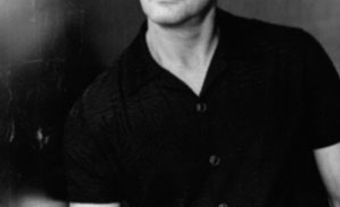Paul Buissonneau, actor, director, author (born 24 December 1926 in Paris, France; died 30 November 2014 in Montréal, QC). After four years with the Compagnons de la chanson (from 1946 to 1950), Buissoneau left the group and settled in Montreal. He took an active part in developing amateur and professional theatre through his dual activities as a municipal civil servant (from 1952 to 1984) and artistic director of the Théâtre de Quat'Sous (from 1965 to 1984).
Paul Buissonneau
While Paul Buissonneau was languishing as a record salesman, Claude Robillard, then at the helm of the Montreal Parks Commission, invited him to develop La Roulotte. This itinerant stage, which circulated in city parks in the summer, introduced generations of children to the theatre for free, and served as a training ground for a large number of youth including Yvon Deschamps, Claude Léveillée, Jean-Louis Millette, Jean Perreault and François Barbeau.
As a city instructor, Buissonneau formed and organized a company of amateurs, the Théâtre de Quat'Sous (1955), with whom he had his first success as director at the Festival national d'art dramatique presenting plays where his imagination and fantasy worked wonders: Orion le tueur (1956) by Jean-Pierre Grenier and Maurice Fombeure as well as La tour Eiffel qui tue (1957) by Guillaume Hanoteau. To broaden the city services for amateurs, in 1958 he formed the Atelier, where he gave student workshops, and in 1959 at the Centre dramatique he inaugurated introductory courses in mime and body movement, techniques that he himself had practised in Paris with Chancerel's followers. In 1981, he took part in setting up the Maisons de la culture.
In the early 1960s, he enfranchised his company, now turned professional. It was housed on Avenue des Pins Ouest in an old synagogue converted into a charming 160-seat theatre. After its inauguration in 1965, he assumed the artistic leadership. Following several years of fanciful and light contemporary French programming, the artistic director of Quat’Sous opened up its stage to Québécois theatre, then bubbling with the excitement of the younger generation. After l'Osstidcho (1968), collective creations followed, which spectators discovered with zeal: André Brassard's productions, several plays by Michel Tremblay, including À toi pour toujours, ta Marie-Lou. Michel Garneau, Marc Drouin, Normand Chaurette and René-Daniel Dubois, then just starting out, were welcomed, as were a number of young companies including Omnibus and the Théâtre Ubu.
Among Buissonneau's most noted plays are Faut jeter la vieille (Théâtre du Nouveau Monde, 1969) by Dario Fo, adapted by Buissonneau and Jean-Louis Roux; La crique (Théâtre de Quat’Sous, 1978) by Guy Foissy; L’oiseau Vert de Gozzi (TNM, 1998) and Les Chaises (Théâtre du Rideau Vert, 2000) by Eugène Ionesco.
Buissonneau also directed opera for Radio-Canada television. Rossini's Le Barbier de Séville, Gioachino Rossini’s opera (produced by Pierre Morin) won him an Emmy Award from New York in 1965. He created the whimsical Picolo from La Boîte à surprises (1954) for the children and went on to play this character for almost 20 years.
In 1984, Buissonneau gave up the artistic leadership of Quat'Sous as well as his position as a municipal civil servant. In 1976, he received the prix Victor Morin for his contribution to theatre, and in 1998, the Governor General’s Award. In 1991, he published Les comptes de ma mémoire.

 Share on Facebook
Share on Facebook Share on X
Share on X Share by Email
Share by Email Share on Google Classroom
Share on Google Classroom

